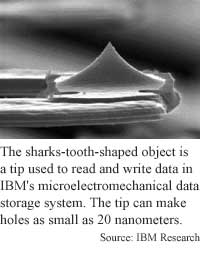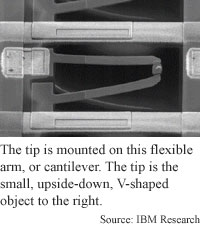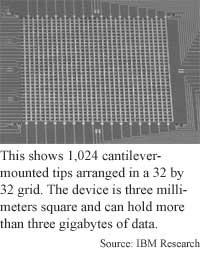
Mechanical data storage goes massively parallel
By Eric Smalley, Technology Research NewsIBM's Millipede project is finally living up to its name. The latest protype in the project, which aims to use microelectromechanical systems as data storage devices, sports more than one thousand read-write heads.
Researchers at IBM's Zürich laboratory have demonstrated a three-millimeter-square device that uses an array of 32 by 32 atomic force microscope probe tips to read and write data by sensing and making tiny indentations on a surface.
Millipede's highly parallel nature makes it potentially very fast. The tips are small enough that the device will be able to store more data per square inch than today's magnetic media. It is small, uses little power and should be cheap to produce because it is a microelectromechanical system (MEMS). MEMS are essentially computer chips with moving parts.
MEMS devices could provide large amounts of data storage capacity for systems ranging from computers to cell phones to household appliances, especially if magnetic data storage technologies eventually bump up against the laws of physics.
"Magnetic storage is progressing at such a rate that it makes it difficult to compete with it using other technologies," said Cal Quate, a professor of electrical engineering at Stanford University. "I think that the Millipede [technology] has the best chance if the magnetic systems run out of steam."
Tiny actuators, which are electrically or magnetically controlled springs, move the device's storage medium laterally and longitudinally relative to the tips. The movement is enough to give each tip its own section of the surface to operate on. Other actuators gently press the surface against the tips.
To write a "1" in the binary language of computers, the device sends a small electrical current into a tip, which heats it up enough to melt a small indentation in the surface. A "0" is represented by the unaltered surface. The device reads a bit by sensing the change in electrical potential in a tip caused by changes in temperature. When a tip is in an indentation, more of the tip is in contact with the surface so heat dissipates more quickly. The whole device can be erased by heating the entire surface.
The Millipede protype has achieved data densities of 100 to 200 gigabits per square inch, several times higher than the current state-of-the-art in magnetic storage devices, said Gerd K. Binnig, an IBM Fellow at IBM Research in Switzerland.
The indentations in the 1,024-tip device are 80 nanometers apart, and the researchers have demonstrated spacings as small as 40 nanometers with individually operated tips, he said. A nanometer is one millionth of a millimeter.
The spacings are determined in part by the storage medium. The current protype uses a thin film of the polymer polymethylmethacrylate, though the researchers have indications that other polymers might give better results, Binnig said. "In the past we did not play with different polymers. In the future we will," he said.
The storage density is also dependent on how the system reads bits. The researchers have tested a coding scheme in which indentations are so close that adjacent bits run together, forming trenches. The device determines the number of bits by sensing the length of the trench, said Binnig. IBM has not settled on a coding scheme for the device, he said.
The current Millipede prototype is far slower at transferring data than magnetic media, though it has the potential to outstrip it considerably, said Binnig. "Today's data rate is just limited by the current laboratory hardware implementation," he said.
The 32 by 32 array can transfer data from a processor to the storage medium or vice versa at one megabit per second, Binnig said. Current magnetic disks transfer data at rates up to 20 megabits per second, and arrays of disk drives can go higher.
"Much higher data rates will be achieved by truly parallel reading [and] writing of all tips simultaneously," said Binnig. "This requires integrated electronics which we will have [at the] end of next year."
Each Millipede tip has a data transfer rate of about 100 kilobits per second. When the array operates in parallel, it should have a data transfer rate of about 400 megabits per second. Future versions of the Millipede device could have as many as one million tips, which would have a collective data transfer rate of 100 gigabits per second, said Binnig.
"The Millipede [technology] is very well done and many of the aspects that held it back in the past have been overcome. The tips are uniform. They have high writing speed [and] high throughput," said Quate.
IBM plans to use the technology in commercial products in three to five years, said Binnig.
Binnig's colleagues were M. I. Lutwyche, M. Despont, U. Drechsler, U. Dürig, W. Häberle, H. Rothuizen, R. Stutz, R. Widmer and Peter Vettiger. They published their work in the November 13, 2000 issue of Applied Physics Letters.
Timeline: 3-5 years
Funding: Corporate
TRN Categories: MicroElectricMechanical Systems (MEMS); Data Storage Technology
Story Type: News
Related Elements: Image 1, Image 2, Image 3; Technical paper "Highly parallel data storage system based on scanning probe arrays," Applied Physics Letters, November 13, 2000
Advertisements:
December 6, 2000
Page One
Biomotor powers propeller
Safe havens offer practical quantum processing
Mechanical data storage goes massively parallel
Frosted nanotubes make metal wires
Interference delivers atomic details



News:
Research News Roundup
Research Watch blog
Features:
View from the High Ground Q&A
How It Works
RSS Feeds:
News
Ad links:
Buy an ad link
| Advertisements:
|
 |
Ad links: Clear History
Buy an ad link
|
TRN
Newswire and Headline Feeds for Web sites
|
© Copyright Technology Research News, LLC 2000-2006. All rights reserved.